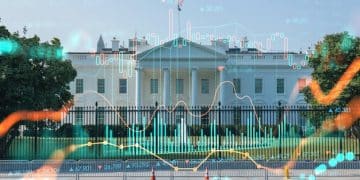How New US Trade Tariffs Could Impact Consumer Goods Prices in 2025

How Will the New US Trade Tariffs Impact Consumer Goods Prices in 2025? New tariffs may lead to increased costs for imported goods, potentially raising prices for consumers on various products from electronics to clothing.
The prospect of new trade tariffs imposed by the United States raises significant questions about their potential effects. A primary concern is, how will the new US trade tariffs impact consumer goods prices in 2025?. Analyzing this question is essential for consumers and businesses alike.
Understanding how these changes could affect everyday expenses and overall market dynamics is crucial for preparing for 2025. Let’s delve into the potential scenarios and economic impacts of these tariffs.
Understanding the Basics of US Trade Tariffs
Trade tariffs are essentially taxes imposed on goods imported into or exported from a country. These tariffs play several roles, from protecting domestic industries to generating revenue for the government.
Why Are Trade Tariffs Implemented?
Governments use trade tariffs for various reasons. Tariffs can protect domestic industries from foreign competition by making imported goods more expensive. This gives local businesses a competitive edge. Furthermore, tariffs can serve as a tool in international trade negotiations. They can also be used to generate revenue for the government, although this is typically a secondary goal.
- Protecting Domestic Industries
- Generating Government Revenue
- Acting as a Negotiation Tool
The impact of tariffs can be complex and multifaceted. While they may benefit certain sectors, tariffs often lead to higher prices for consumers and can disrupt global supply chains. The effectiveness of trade tariffs as a policy tool largely depends on the specific circumstances and the broader economic context.

In conclusion, understanding the basics of trade tariffs is crucial for assessing their potential impact on the economy. Tariffs, while serving specific purposes, carry broad economic consequences that affect both businesses and consumers.
How Will the New US Trade Tariffs Impact Consumer Goods Prices in 2025?
The central question of interest remains: how will the new US trade tariffs impact consumer goods prices in 2025? To answer this, we need to examine various factors, notably the types of goods affected and the magnitude of the tariffs.
Impact on Specific Goods Categories
Consumer goods range from electronics and clothing to food and automobiles. The impact of tariffs on these categories will vary significantly based on where these goods are imported from and the size of the tariffs imposed. For example, if tariffs are placed on electronics imported from Asia, consumers could see a noticeable increase in the prices of smartphones, laptops, and other gadgets.
- Electronics: Higher prices for smartphones and laptops.
- Clothing: Increased costs for imported apparel.
- Food: Potential rise in grocery bills due to tariffs on imported food items.
The cumulative effect could be considerable, especially if tariffs are broad-based. As retailers face higher import costs, they will likely pass those costs onto consumers through increased prices. This could lead to decreased purchasing power and changes in consumer behavior as people adjust their spending habits to accommodate the higher costs.
Ultimately, whether the tariffs will result in significant or moderate price increases depends on the specifics of the trade policies implemented. Closer monitoring of these policies is essential for understanding the precise effects. The key question is, **how will the new US trade tariffs impact consumer goods prices in 2025?**.
Analyzing Potential Economic Scenarios
Considering potential economic scenarios is crucial when determining how new US trade tariffs might affect consumer goods prices in 2025. Three scenarios—optimistic, moderate, and pessimistic—offer a range of possible outcomes.
Optimistic Scenario: Minimal Impact
In an optimistic scenario, the new tariffs are implemented selectively and strategically, targeting specific industries without causing widespread price increases. This could involve focusing on goods for which domestic alternatives are readily available, limiting the overall impact on consumers. Furthermore, trade negotiations could lead to reduced tariff rates or exemptions, softening the impact on imported goods.
Moderate Scenario: Selective Price Increases
A moderate scenario might involve broader implementation of tariffs, but balanced by countervailing measures to mitigate the impact on consumers. This could include government subsidies for affected industries or tax breaks for consumers to offset higher prices. In this case, while some price increases are inevitable, they are managed to avoid significant disruptions to consumer spending.
Monitoring economic indicators and policy announcements will be essential to gauge the actual impact of the tariffs. The question of **how will the new US trade tariffs impact consumer goods prices in 2025?** requires careful attention to policy changes and market responses that could change the outcome.

The Role of Supply Chains and Global Trade
Global supply chains play a pivotal role in determining how new US trade tariffs affect consumer goods prices. Disruptions to these chains can significantly amplify the impact of tariffs.
Effects on Supply Chain Efficiency
When tariffs are imposed on imported components or raw materials, businesses face increased costs. To remain competitive, they may need to find alternative suppliers, which can be time-consuming and costly. If supply chains become less efficient, production costs rise, ultimately leading to higher prices for consumers.
- Increased Production Costs
- Disrupted Supply Chains
- Dependence on Imported Goods
The tariffs’ impact can also depend on the level of competition in the market. If there are few alternative suppliers, businesses may have no choice but to absorb the tariff costs and pass them on to consumers. However, in more competitive markets, there may be greater opportunities to mitigate the impact through price adjustments and cost-cutting measures.
The health and stability of global trade relations will play a decisive role in determining the extent to which tariffs affect consumer goods prices. As we consider **how will the new US trade tariffs impact consumer goods prices in 2025?**, it’s essential to monitor these dynamics to fully understand and prepare for potential economic shifts.
Strategies for Consumers and Businesses
Given the uncertainties surrounding **how will the new US trade tariffs impact consumer goods prices in 2025?**, it’s wise for both consumers and businesses to adopt proactive strategies.
For Consumers: Budgeting and Smart Shopping
Consumers should consider several strategies to mitigate the impact of potential price increases. Creating a detailed budget can help track spending and identify areas where costs can be reduced. Comparative shopping becomes even more important, as prices may vary widely among retailers. Consumers may also want to explore buying in bulk when practical, capitalizing on sales and promotions, and considering private-label products, which are often priced lower than name-brand alternatives.
For Businesses: Diversification and Efficiency
Businesses can focus on strategies to mitigate the impact of tariffs on their bottom lines. Diversifying supply chains can reduce dependence on any single country or supplier, minimizing the risk of tariff-related disruptions. Improving operational efficiency, through measures like automation and waste reduction, can help lower production costs and offset the impact of tariffs.
Both consumers and businesses should stay informed about trade policy developments. Knowledge is power, and understanding the nuances of trade policies can aid in making informed decisions and adapting to changing economic conditions. The strategies businesses and consumers employ can significantly affect how they navigate the potential price increases resulting from these tariffs.
Conclusion
In conclusion, understanding **how will the new US trade tariffs impact consumer goods prices in 2025?** requires careful consideration of various factors, including the specifics of the tariffs, the health of global supply chains, and the strategies employed by consumers and businesses. While uncertainties persist, staying informed and proactive can help mitigate the potential negative effects.
| Key Point | Brief Description |
|---|---|
| 📈 Tariff Impact | Tariffs on imported goods may raise consumer prices. |
| 💰 Economic Scenarios | Outcomes range from minimal to significant price increases. |
| ⛓️ Supply Chains | Tariffs can disrupt global supply chains, affecting prices. |
| 🛒 Strategies | Consumers should budget; businesses should diversify. |
Frequently Asked Questions
Trade tariffs are taxes imposed on imported or exported goods. They can protect domestic industries by making imports more expensive, generate revenue, or be used in trade negotiations.
Consumer goods like electronics, clothing, food, and automobiles are likely to be affected. The specific impact depends on where these goods are imported from and the magnitude of the tariffs.
Disruptions in global supply chains due to tariffs can amplify the impact on prices. Inefficient supply chains lead to higher production costs, which are often passed on to the consumer.
Consumers can create budgets, shop comparatively, buy in bulk, and consider private-label products to mitigate the impact of higher prices resulting from new trade tariffs.
Yes, new trade agreements that lower or eliminate tariffs can reduce the impact on consumer goods prices. These agreements promote trade efficiency and can lead to lower costs for consumers.
Conclusion
Understanding **How Will the New US Trade Tariffs Impact Consumer Goods Prices in 2025?** requires a comprehensive view of economic factors and strategic preparation. Staying informed and adaptive is crucial for navigating potential price changes.





